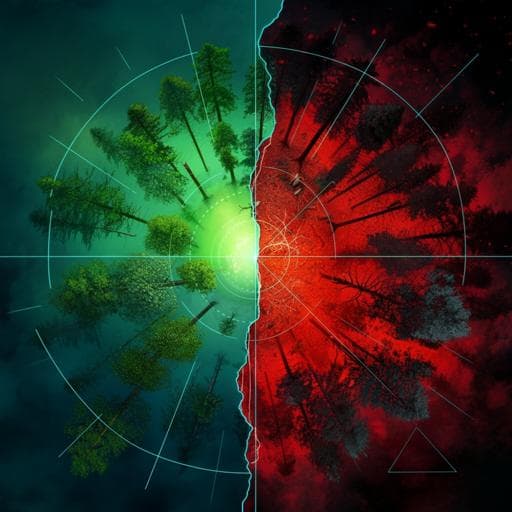
Environmental Studies and Forestry
Conservation policies and management in the Ukrainian Emerald Network have maintained reforestation rate despite the war
L. Shumilo, S. Skakun, et al.
This research conducted by Leonid Shumilo and colleagues delves into the effects of the Russian-Ukrainian War on environmental conservation in the Luhansk region. It uncovers a significant transformation from deforestation to reforestation, revealing that despite the conflict, Ukrainian-controlled areas made strides in forest recovery, while Russian-held zones faced severe loss. Institutional ties play a pivotal role in these conservation outcomes.
~3 min • Beginner • English
Introduction
The study investigates how the Russian‑Ukrainian conflict has affected conservation outcomes within Ukraine’s Emerald Network, a transboundary system established under the Bern Convention to protect biodiversity and promote sustainable land management. Following Ukraine’s accession to the Bern Convention (1996) and national programs to build the Emerald Network (from 2000), policies and legislation aimed to reduce degradation, enhance ecosystem services, and expand protected habitats. Beginning in 2014, parts of Luhansk and Donetsk oblasts were occupied, disrupting conservation governance, monitoring, and management and exposing ecosystems to militarization, pollution, wildfires, and reduced socio‑economic activity. The core research objective is to quantify long‑term tree cover dynamics in Luhansk’s Emerald Network sites across three periods (1996–2000 pre‑Network, 2000–2013 Network establishment, 2013–2020 post‑conflict onset) to assess the effectiveness of Emerald Network policies and the consequences of institutional separation due to occupation. This approach addresses the need for evidence‑based assessment where ground access is impossible, focusing on whether conservation policies sustained reforestation trends despite war and how loss of governance affected forest outcomes across the demarcation line.
Literature Review
The paper situates its analysis within European conservation policy frameworks (Bern Convention; Natura 2000/Emerald Network) and their reported successes, including reforestation and biodiversity protection across Europe. Prior work documents increasing forest cover in Europe (e.g., afforestation and defragmentation trends) and forecasts of stable or expanding forest extent compared to global losses. The Emerald Network has been linked to improved agri‑environmental practices, restoration of natural vegetation, and stabilization of Red List species in countries including Armenia and Ukraine. In contrast, literature on the environmental impacts of armed conflict highlights severe risks to biodiversity, ecosystem services, soils, water, and air quality, with documented wildlife declines in protected areas during conflicts and projections of elevated extinction risk under continued drivers and potential nuclear scenarios. Regionally, studies report cropland losses and socio‑ecological disruption in Eastern Ukraine, widespread pollution from damaged industrial sites, mine flooding and water contamination, catastrophic wildfires, and interruptions to forest management (e.g., sanitary logging, fire risk reduction). The review underscores the crucial role of governance, monitoring, and legal frameworks in mitigating deforestation pressure and maintaining conservation outcomes, while conflicts undermine these institutions, leading to environmental degradation.
Methodology
Study area and periods: Emerald Network sites in the Luhansk region, analyzed over three periods: 1996–2000 (pre‑Emerald Network), 2000–2013 (establishment phase), and 2013–2020 (post‑conflict onset, post‑demarcation), excluding time after the catastrophic 2020 wildfire for certain assessments. Data and mapping: Land‑cover mapping was conducted in Google Earth Engine using multispectral satellite imagery: Landsat‑5 (1996), Landsat‑5/7 (2000), Landsat‑8 (2013), and Sentinel‑2 (2020). Additional Sentinel‑1/2 data supported compositing. Cloud‑free monthly composites were generated, and maps were produced at 30 m resolution in Albers Equal Area projection. Classification: A supervised classification with Random Forest was used, tailoring the number of trees to data volume/complexity (10 trees for 1996/2000, 100 for 2013, 200 for 2020). Target classes included tree cover, grassland, cropland, water bodies, artificial objects, and bare land. Training data: Because ground access was infeasible, 5,000 visually interpreted reference points per year were created via photointerpretation of Landsat/Sentinel imagery and very high‑resolution Google Earth imagery, ensuring coverage of all classes. Validation: An independent set of 1,200 randomly sampled points, not used in training, was labeled for accuracy assessment. Tree cover map F1 scores were 0.90 (1996), 0.90 (2000), 0.84 (2013), and 0.88 (2020). Area estimation and change analysis: To reduce bias from pixel counting errors (resolution limits, mixed pixels, misregistration, classification errors), a stratified random sampling framework was applied following best practices. Strata were defined by temporal tree cover behavior across the four maps: stable forest, forest with changes (≥1 change), and stable non‑forest. A buffering technique mitigated omission error effects on change areas. Required samples for the territory of interest were 876, but to reduce uncertainty due to high forest fragmentation, separate sample sets were generated per Emerald site: 2,665 samples (Ukraine‑controlled) and 2,327 (Russia‑controlled). Standard estimators were used to compute areas and errors for change categories (tree cover gain, loss, stable, stable non‑forest) and to derive annual rates and net changes over each period. Governance context analysis: Legal and policy timelines (Forestry Codex of Ukraine and subsequent amendments; national programs and strategies) were reviewed to interpret observed trends and differences across the demarcation line in terms of management, monitoring, and enforcement.
Key Findings
- Mapping accuracy: Tree cover F1 scores were 0.90 (1996), 0.90 (2000), 0.84 (2013), and 0.88 (2020).
- Pre‑Network (1996–2000): Deforestation on both future sides of the demarcation line. Ukraine‑controlled territories: −0.86 ± 0.22 thousand ha/year (total −3.42 ± 0.86 thousand ha). Territories later under Russian control: −0.28 ± 0.10 thousand ha/year (total −1.10 ± 0.40 thousand ha).
- Emerald establishment (2000–2013): Reforestation on both sides. Ukraine‑controlled: +0.67 ± 0.09 thousand ha/year (total +8.69 ± 1.20 thousand ha). Territories later under Russian control: +0.19 ± 0.06 thousand ha/year (total +2.48 ± 0.79 thousand ha).
- Post‑conflict onset (2013–2020): Divergent trends. Ukraine‑controlled territories continued reforestation at +1.19 ± 0.18 thousand ha/year (total +8.30 ± 1.25 thousand ha). Russia‑controlled territories experienced rapid deforestation at −1.23 ± 0.15 thousand ha/year (total −8.58 ± 1.00 thousand ha), losing approximately 25% of forest cover relative to 2013.
- Siverskyi Donets floodplain sites (split by demarcation line): From 2013 to 2020, Ukraine‑controlled areas gained 18% forest area, while Russia‑controlled areas lost 31%.
- Cumulative Ukraine‑controlled gains: Total reforestation of 11.17 ± 1.45 thousand ha before the conflict; 17 ± 1.74 thousand ha from 2000 to 2020.
- Institutional effect: Territories under Ukrainian governance sustained conservation and reforestation despite increased regional vulnerability, whereas territories separated from Ukrainian institutions and policies saw pronounced forest loss.
- Tree cover area totals (thousand ha): Ukraine‑controlled: 85.12 (1996), 82.70 (2000), 91.39 (2013), 99.69 (2020). Russia‑controlled: 33.96 (1996), 32.86 (2000), 35.34 (2013), 26.76 (2020).
Discussion
The analysis demonstrates that establishing and maintaining conservation governance under the Emerald Network and associated Ukrainian forestry legislation shifted deforestation (1996–2000) to sustained reforestation (2000–2020) in Ukraine‑controlled Emerald sites. After the 2014 conflict and demarcation, the continuity of Ukrainian policies, monitoring, and management (e.g., reforestation mandates, fire prevention, logging controls, electronic wood accounting and permitting) supported continued forest gains despite war‑related vulnerabilities. In contrast, separation from Ukrainian institutions in Russia‑controlled areas coincided with the cessation of key forest management practices and oversight, leading to substantial net forest loss (about −25% from 2013 to 2020), including severe declines in the ecologically critical Siverskyi Donets floodplain. These findings address the research question by evidencing the pivotal role of conservation institutions and policy implementation in sustaining ecosystem recovery and resilience under conflict. They underscore that governance continuity and adherence to legal frameworks can maintain positive conservation trajectories even amid external shocks, whereas institutional disruption rapidly erodes decades of progress, with implications for biodiversity, ecosystem services, and regional ecological security.
Conclusion
The study provides quantitative evidence that the Emerald Network’s conservation policies and Ukraine’s strengthened forestry governance transformed deforestation into reforestation and maintained positive forest trends in Luhansk’s protected areas despite the war. Conversely, the war‑induced separation of territories from Ukrainian institutions led to dramatic forest losses in occupied areas, effectively erasing two decades of conservation gains. These results highlight the importance of institutional capacity, monitoring, and enforcement for sustaining ecosystem recovery under crisis conditions. Future work should extend the methodology to other Ukrainian regions, incorporate post‑2020 observations to assess impacts of catastrophic wildfires and the 2022–2023 escalation, and integrate additional ecological indicators (e.g., habitat quality, species trends, disturbance regimes) to comprehensively evaluate post‑war conservation damage and guide restoration planning.
Limitations
- Ground‑based data collection was infeasible due to active conflict and lack of historical access; training and validation relied on photointerpretation of satellite imagery.
- The analysis period ends in 2020 (pre‑catastrophic wildfire impacts and prior to the 2022–2023 large‑scale escalation), limiting inference about more recent changes.
- Map‑derived area estimates are subject to classification and registration errors; a stratified sampling and buffering approach mitigated but did not eliminate bias.
- Results focus on tree cover and do not directly assess other conservation dimensions (e.g., species populations, habitat quality, or ecosystem services) that may exhibit different dynamics.
- Attribution to policy and governance is based on temporal and spatial contrasts and documented legal changes; unobserved confounders (e.g., local socioeconomic shifts, unrecorded disturbances) may also contribute.
Related Publications
Explore these studies to deepen your understanding of the subject.







